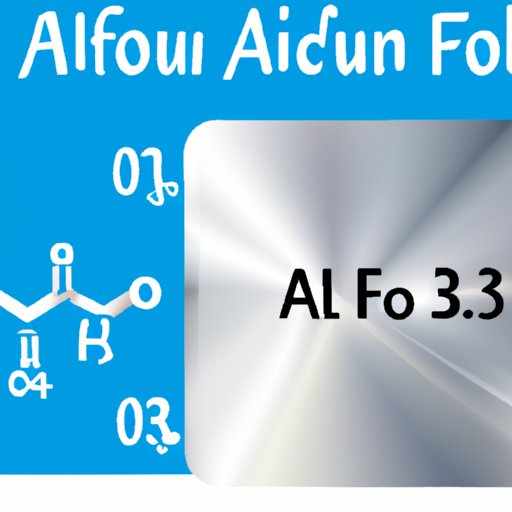Introduction
Aluminum fluoride (AlF3) is a compound composed of aluminum and fluoride ions, which are held together by ionic bonds. This compound has a variety of industrial applications, as well as several benefits that make it an ideal choice for certain projects. In this article, we will explore the chemical composition of aluminum fluoride, examine its uses and benefits, discuss how it is produced, look at its properties, analyze its environmental impact, and investigate its health and safety concerns.
Exploring the Chemical Composition of Aluminum Fluoride
At its core, aluminum fluoride is made up of two elements: aluminum (Al) and fluoride (F). Each element contributes to the overall structure and properties of the compound. To better understand how these elements work together, let’s break down the AlF3 formula.
The AlF3 formula contains one atom of aluminum and three atoms of fluoride. This means that there is one aluminum ion (Al3+) and three fluoride ions (F-) in each molecule. The positive charge of the aluminum ion is balanced out by the negative charge of the three fluoride ions. This creates a neutral molecule that is held together by strong ionic bonds.
The combination of aluminum and fluoride creates a compound with unique properties. For example, aluminum fluoride has a high melting point (1,220°C) and boiling point (1,835°C), making it very stable at high temperatures. It also has a low solubility in water (0.03 g/L at 25°C) and is highly resistant to corrosion. These properties make aluminum fluoride useful for a variety of applications.

Examining the Uses and Benefits of Aluminum Fluoride
Aluminum fluoride is used in a variety of industries and applications. One of the most common uses of aluminum fluoride is as a flux agent in welding and soldering. When heated, it helps to reduce surface tension and improve the flow of molten metal. As a result, it is often used in the production of aluminum alloys and steel products.
Aluminum fluoride is also used in the production of ceramics and glass, as it acts as a bonding agent that helps to bind the materials together. It is also used as a catalyst in chemical reactions, as well as a cleaning agent in various industrial processes. Additionally, aluminum fluoride can be used to produce aluminum salts, which have a variety of applications in pharmaceuticals, cosmetics, and other industries.
In addition to its practical applications, aluminum fluoride also offers several benefits. For example, it is non-toxic and does not release any hazardous fumes or vapors when heated. It also has a low solubility in water, making it safe to use in water-based processes. Furthermore, aluminum fluoride is relatively inexpensive and easy to obtain, making it a cost-effective option for many applications.
A Look at How Aluminum Fluoride is Produced
Aluminum fluoride is typically produced through a process known as electrolysis. This involves passing an electric current through a solution of aluminum chloride and hydrofluoric acid. During this process, the aluminum and fluoride ions separate from the solution and bond together to form aluminum fluoride.
The raw materials used in the production of aluminum fluoride are usually sourced from natural deposits. Aluminum is commonly mined from bauxite ore, while fluoride can be obtained from fluorite or cryolite deposits. Once the raw materials have been obtained, they are processed and purified before being used in the production process.

Understanding the Properties of Aluminum Fluoride
Aluminum fluoride has a number of distinct physical and chemical properties. Physically, it is a white, crystalline powder that is odorless and tasteless. It is insoluble in water but soluble in acids, such as hydrochloric acid and sulfuric acid.
Chemically, aluminum fluoride is quite stable. It has a high melting point (1,220°C) and boiling point (1,835°C), making it ideal for high-temperature applications. It is also highly resistant to corrosion, making it a suitable choice for certain industrial processes.

Analyzing the Impact of Aluminum Fluoride on the Environment
Aluminum fluoride can have a significant impact on the environment, particularly if it is released into the air or water. When it is inhaled, aluminum fluoride can cause irritation to the respiratory system and can even lead to long-term damage. It can also contaminate groundwater and soil if it is spilled or leaked, leading to potential health risks for humans and animals.
To mitigate the environmental impact of aluminum fluoride, it is important to properly store and dispose of the compound. Additionally, it is important to use protective equipment when handling the compound, as well as take measures to ensure that leaks and spills are avoided.
Investigating Health and Safety Concerns Surrounding Aluminum Fluoride
While aluminum fluoride is generally considered safe, there are some health and safety concerns associated with its use. In particular, exposure to aluminum fluoride can irritate the skin and eyes, as well as cause breathing difficulties. Long-term exposure can also lead to more serious health problems, such as kidney disease and neurological disorders.
To protect against potential health risks, it is important to wear protective clothing and equipment when handling aluminum fluoride. It is also important to avoid inhalation of the compound and to keep it away from food and drink. Additionally, it is important to store aluminum fluoride in a cool, dry place away from direct sunlight.
Conclusion
In conclusion, aluminum fluoride (AlF3) is a compound composed of aluminum and fluoride ions that is used in a variety of industrial applications. Its chemical composition and properties make it an ideal choice for certain projects, and its benefits make it a cost-effective option. However, it is important to be aware of its potential environmental and health impacts, as well as the necessary precautions to take to protect against them.

